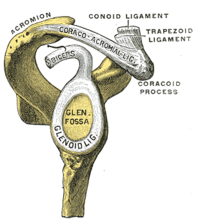
Photo from wikipedia
This study evaluated the role of anchor position in persistence of pain and/or revision biceps tenodesis after arthroscopic repair of type II superior labrum anterior and posterior (SLAP) lesions and… Click to show full abstract
This study evaluated the role of anchor position in persistence of pain and/or revision biceps tenodesis after arthroscopic repair of type II superior labrum anterior and posterior (SLAP) lesions and assessed for patient- and injury-specific variables influencing clinical outcomes. Active-duty service members who underwent arthroscopic repair of type II SLAP lesions between March 1, 2007, and January 23, 2012, were identified. Patients with less than 2-year clinical follow-up; type I, III, and IV SLAP lesions; and primary treatment with biceps tenodesis and/or rotator cuff repair at the time of index surgery were excluded. Demographic, preoperative, and operative variables, including anchor positions, were reviewed and evaluated for association with outcomes. Total failure rate (defined as either surgical and/or clinical failure), anchor position, and return to military function were the primary outcomes of interest. Forty-nine patients underwent type II SLAP repairs with a mean follow-up of 52.3 months. Forty-eight (97.9%) were men, and mean age was 35.2 years. Eleven patients (22%) underwent subsequent subpectoral biceps tenodesis. Forty patients (82%) returned to military function, whereas 9 patients (18%) had medical discharge for significant, rate-limiting, shoulder pain. Age was a significant predictor of surgical failure. Patients with anchor position anterior to the biceps attachment had no increased risk of clinical or surgical failure compared with patients with only posterior-based anchors. Anchor placement anterior to the biceps tendon was not associated with inferior outcomes. Younger age was shown to be a poor prognostic factor in patients' ability to return to active duty. Revision with biceps tenodesis showed significant utility in achieving good clinical outcomes and return to duty in more than 90% of patients. Patient-, injury-, and surgery-specific variables need to be identified as prognostic indicators so that clinical outcomes can continue to be improved. [Orthopedics. 2019; 42(1):e32-e38.].
Journal Title: Orthopedics
Year Published: 2019
Link to full text (if available)
Share on Social Media: Sign Up to like & get
recommendations!